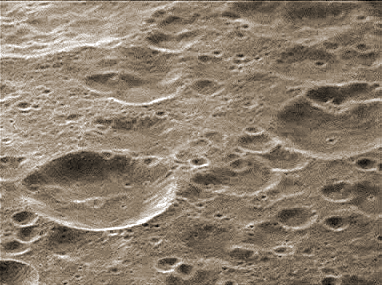
These are two views of Delisle crater, 30.0 N, 325.4 E.
You may have to move back from your monitor to view these images comfortably in stereo because they are more widely spaced than usual because they were assembled from mosaics.
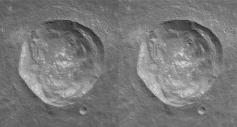 The
first image is a mosaic stereo view, made from 900 and 1100 nm images from
Clementine orbit 127.
The
first image is a mosaic stereo view, made from 900 and 1100 nm images from
Clementine orbit 127.
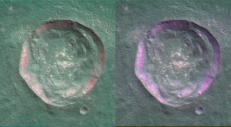 The
second image is multi-spectral false color quasi-stereo image made from
450, 1100, and 900 nm images on the left, and 450, 950, and 750 nm images
on the right, mapped to red-green-blue.
The
second image is multi-spectral false color quasi-stereo image made from
450, 1100, and 900 nm images on the left, and 450, 950, and 750 nm images
on the right, mapped to red-green-blue.
There are many anomalous features that can be seen in this image. There is a 'ramp' at 12:30 that appears to connect the terrace on the right inside of the crater to the lunar surface. At 11:30 a bridge appears to connect the two sides of an area which appears to have been created by ejecta as evidenced by the linear streak across this area which can also be seen above the rim of the crater. To the right of this area other possible linear structures can be seen.
At 12:00 there is a curved feature which appears to connect from the lunar surface to the inside wall of the crater. Below this curved feature is another linear feature which appears to be similar to the bridge and ramp.
Below and to the left of this bridge is an unusual round cutout area near the rim of the crater as well as debris on the nearby lunar surface. This may be an impact crater but it appears to be connected to several unusual linear and curved structures.
At 5:30 there is also an unusual circular feature which does not appear to be an impact crater. There is a 'winding road' feature above this circular feature and a linear feature to the left of the beginning of the road.
Many of these structures do not appear to be of natural origin, especially
considering the number of anomalies appearing together in this unusual
crater.
The Antonin Rukl Lunar Atlas
Chart - Section 19
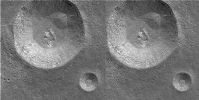 This
stereo image of the crater Diophantus is made from the 900nm and 950nm
UVVVIS images from Clementine orbit 313, 27.55 degrees latitude, 325.36
degrees longitude.
This
stereo image of the crater Diophantus is made from the 900nm and 950nm
UVVVIS images from Clementine orbit 313, 27.55 degrees latitude, 325.36
degrees longitude.
Some may find this pyramid-shaped mound to be merely the result of a landslide on the steep slopes of this unusual crater. However, a close inspection of this unusually clear image suggests that there may be other possibilities.
The area to the right of the pyramid mound shows evidence of a path which extends from the some of the dark areas in the side of the crater, over the pyramid and down the left side and past the left of the large rock near the center of the crater, to a nozzle-shaped projection that extends from lower left side of the crater. Could projection be some type of laser tunnel boring machinery being used to tunnel into the uppper right wall of the crater. What might lie within this possible lunar tunnel complex?
Other paths can be seen connecting areas below the previous path, across the side of the pyramid mound, and other areas within the crater.
Another anomalous structure is the linear structure to the right of the rock debris and the bright object directly below the linear object, as well as the rock which comes to a very sharp point, judging from the stereo image. This area is also apparently connected to the lower right side of the crater by several linear structures which appear to connect to other linear structures that traverse the rim of the crater.
The area below the rock debries is also very unusual, revealing a tube-like object that appears to connect the lighter area to the side of the crater.
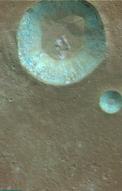
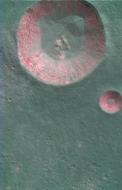 These
are false color images made from 1100, 750, and 450 nm (first image), and
450, 1100, and 900 nm images mapped to red-green-blue. The left and upper
left sides of the crater contain unusual rock strucures, including arch-like
structures or possibly unusual rock faces which show up clearly in red
in the second image. This view shows unusual linear structures leading
up to the 'laser cannon' anomaly, and illustrate that the pyramid was probably
formed after the crater was formed since it shows none of the deposits
which line most of the walls of the crater. The unusual anomaly at 10:30
can be seen clearly in this view and appears to be a possible double opening
to a tunnel.
These
are false color images made from 1100, 750, and 450 nm (first image), and
450, 1100, and 900 nm images mapped to red-green-blue. The left and upper
left sides of the crater contain unusual rock strucures, including arch-like
structures or possibly unusual rock faces which show up clearly in red
in the second image. This view shows unusual linear structures leading
up to the 'laser cannon' anomaly, and illustrate that the pyramid was probably
formed after the crater was formed since it shows none of the deposits
which line most of the walls of the crater. The unusual anomaly at 10:30
can be seen clearly in this view and appears to be a possible double opening
to a tunnel.
 This
image has been adjusted to show the strange tube-like structures on the
inside of the crater in the same area of the arches, which seem to be connected
to translucent tubes that converge on the lower side of the crater. This
image is rotated ninety degrees counterclockwise compared to the stereo
image above.
This
image has been adjusted to show the strange tube-like structures on the
inside of the crater in the same area of the arches, which seem to be connected
to translucent tubes that converge on the lower side of the crater. This
image is rotated ninety degrees counterclockwise compared to the stereo
image above.
Could this pyramid mound be the result of a tunneling or mining operation
in the base and/or sides of the crater, possibly using a laser tunnel boring
machine?
 This
image shows an overview of an anomalous area from orbit 245, centered at
24 degrees latitude, 151 degrees longitude, on the farside of the moon,
showing a strange complex consisting of deep grooves in the lunar surface.
This
image shows an overview of an anomalous area from orbit 245, centered at
24 degrees latitude, 151 degrees longitude, on the farside of the moon,
showing a strange complex consisting of deep grooves in the lunar surface.
 This
is a mosaic made from several images from orbit 245 showing the same area
in greater detail. The deep grooves or canyons seem very out of place compared
to other areas of the lunar surface. What could cause such deep grooves?
This
is a mosaic made from several images from orbit 245 showing the same area
in greater detail. The deep grooves or canyons seem very out of place compared
to other areas of the lunar surface. What could cause such deep grooves?
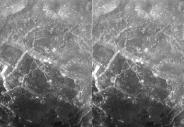 This
is a stereo image of the highly anomalous area.
This
is a stereo image of the highly anomalous area.
 This
area has been censored from the Navy Clementine Lunar Image Browser, which
returns this image of the anomalous area. This image is centered at 24
degrees latitude, 148 degrees longitude. Several weeks earlier, the Clementine
Lunar Image Browser returned the same image, except that it was located
at 24 degrees latitude, 151 degrees longitude. Have the image maps been
offset to make it more difficult to zero in on anomalous features?
This
area has been censored from the Navy Clementine Lunar Image Browser, which
returns this image of the anomalous area. This image is centered at 24
degrees latitude, 148 degrees longitude. Several weeks earlier, the Clementine
Lunar Image Browser returned the same image, except that it was located
at 24 degrees latitude, 151 degrees longitude. Have the image maps been
offset to make it more difficult to zero in on anomalous features?
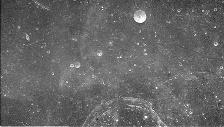 This
mosaic is from Clementine orbit 55, 10-13 degrees N Latitude, 308 degrees
E Longitude. The mosaic has been rotated 90 degrees from the original images;
north is to the right side; the filter is 750 nm.
This
mosaic is from Clementine orbit 55, 10-13 degrees N Latitude, 308 degrees
E Longitude. The mosaic has been rotated 90 degrees from the original images;
north is to the right side; the filter is 750 nm.
This mosaic shows an amazing variety of anomalies:
Most striking, many of the craters have a dark spot in the center and are unusually bright. The medium size crater in the upper part of the image appears to have several radial spokes, that may be some type of support structure for a dome enclosure, which would explain the unusual bright reflection. This may be the case with the smaller bright craters, the center area being a tower or other support point for a large canopy or dome. This is of course one of many possibilities, but one that does explain the unusual appearance of these craters.
Notice the strange twisting, snake-like feature at the lower left. There appears to be a second, linear structure with a Y at the left end, which this 'snake' seems to be twisting around at the right, while the linear structure passes over the 'snake'.
Then above the 'snake' is the 'whale', which has a strange elliptical shape. Was this caused by a glancing meteor strike? Or is it some type of anomalous structure?
Above the 'whale' is a strange linear groove that appears to be broken up at one point by a crater. Another glancing meteor strike?
Of course the most fascinating feature, which I have left for last, is Marius crater, part of which can be seen at the bottom of the mosaic. Starting from the left side, at approximately 11:00, one can see several striking anomalies. There is a dark spot which seems to be surrounded by several strange features. There is a row of smaller round objects that seem to be lined up in a very regular manner. This may be the upper support structure of an inverted U-shaped elliptical dome, or above ground tunnel-like structure, similar to a structure that appeared in Mosaic26 at the upper left hand side of the large crater.
There is also a collection of linear structures, which appear to resemble large cranes or chutes as observed from nearly directly above, at approximately 11:45 on the rim of the crater, which connect from the inside of the crater to a nearby circular feature, with a linear structure that connects a dark central area (tower?).
There are other, more subtle linear features that can be seen as one
moves to the right around the rim of the large crater, including several
unusual features at approx. 1:00 and other linear anomalies at 2:00 connected
to anomalous appearing objects on the rim of the large crater.
 This
is a stereo image of the center image above, from 900 nm and 750 nm images.
Many of the anomalous linear structures can be seen more clearly in this
image.
This
is a stereo image of the center image above, from 900 nm and 750 nm images.
Many of the anomalous linear structures can be seen more clearly in this
image.
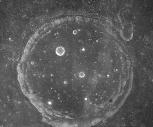 This
is mosaic showing the entire Marius crater, inverted compared to the images
above. Note the strange crater at 1:30 and the many unusual linear and
circular features both inside and outside of the crater.
This
is mosaic showing the entire Marius crater, inverted compared to the images
above. Note the strange crater at 1:30 and the many unusual linear and
circular features both inside and outside of the crater.
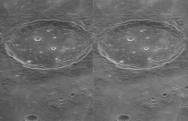 This
stereo image was made from 750 nm and 1000 nm images from Clementine. North
is toward the left. At 12:00 there are several linear structures which
curve over the rim of the crater and connect to the inside wall. The structure
just to the right of the 12:00 point appears to connect to the inside of
a cave or tunnel at the top of the inner wall. The area beneath this object
contains another strange circular feature in the wall of the crater. There
are several more of these strange maze-like circular features that appear
below anomalous features on the rim of the crater.
This
stereo image was made from 750 nm and 1000 nm images from Clementine. North
is toward the left. At 12:00 there are several linear structures which
curve over the rim of the crater and connect to the inside wall. The structure
just to the right of the 12:00 point appears to connect to the inside of
a cave or tunnel at the top of the inner wall. The area beneath this object
contains another strange circular feature in the wall of the crater. There
are several more of these strange maze-like circular features that appear
below anomalous features on the rim of the crater.
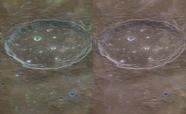 These
images also reveal a strange curved feature within the lower part of the
rim at 7:00 that appears to be a pipe or tube. There is also a structure
which runs over the edge of the crater at 9:00 surrounded by several anomalous
objects, including a very strange circular feature with a linear projection
at the base of the crater just below the feature at 9:00.
These
images also reveal a strange curved feature within the lower part of the
rim at 7:00 that appears to be a pipe or tube. There is also a structure
which runs over the edge of the crater at 9:00 surrounded by several anomalous
objects, including a very strange circular feature with a linear projection
at the base of the crater just below the feature at 9:00.
This is a multi-spectral stereo image made from 950, 750, and 415 nm images on the left, and 1000, 900, and 750 nm images on the right, mapped to red-green-blue. This images shows clearly several anomalies in addition to those described above. The features described at 12:00 and 7:00 are clearly visible in this image as well as others that can be seen with extended viewing. This crater is full of subtle, but very strange anomalies.
The is also a strange triangle-shaped feature in the upper left corner of the image resembling an AOL logo!
There is an unusual rectangular feature outside the rim of the crater at 7:00 which resembles the roof of a large building. To the right of this feature in the left frame is a red pixel. This anomaly appears in only one 950 nm frame. While it may be a bit error, it does not appear to be one for the following reason:
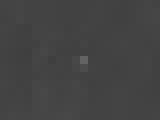 (portion
of 950 nm image) Examining the relationship of the anomaly grescale level
of 99 in the raw image, compared to the background of 60-72 in surrounding
pixels, with the exception of one pixel directly below the feature which
has the value of 76, which may indicate an overlap of a very real bright
feature to the adjacent pixel. This appears to be either a single bit error
or a Lunar Transient Phenomina (LTP).
(portion
of 950 nm image) Examining the relationship of the anomaly grescale level
of 99 in the raw image, compared to the background of 60-72 in surrounding
pixels, with the exception of one pixel directly below the feature which
has the value of 76, which may indicate an overlap of a very real bright
feature to the adjacent pixel. This appears to be either a single bit error
or a Lunar Transient Phenomina (LTP).
The Antonin Rukl Lunar Atlas
Chart - Section 29
 This
is another mosaic of images from Clementine. The area is approximately
37 degrees South Latitude, 193 degrees West Longitude (167 degrees East
Longitude). Right in the middle of the farside of the moon. Here is a larger,
colorized version of the same mosaic which shows some of the subtler
anomalies more clearly.
This
is another mosaic of images from Clementine. The area is approximately
37 degrees South Latitude, 193 degrees West Longitude (167 degrees East
Longitude). Right in the middle of the farside of the moon. Here is a larger,
colorized version of the same mosaic which shows some of the subtler
anomalies more clearly.
Are these long, deep groves simply faults within the huge crater? This
is a very large area, each pixel equal to approximately 1 km. This was
taken on the last orbit of Clementine, 348, as the spacecraft was boosting
it's orbit to escape velocity for an unsucessful rendevous with a nearby
asteroid.
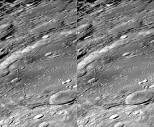
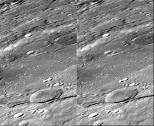
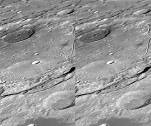 These
stereo images give a 3-D
These
stereo images give a 3-D
perspective of the unusual anomalies.
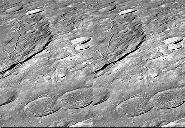
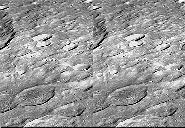
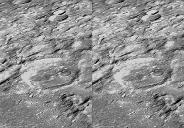
 This
is an a false color image from 900, 950, and 1000 nm images of the area
on the left side of the crater above. The false color processing highlights
some of the anomalies in the image.
This
is an a false color image from 900, 950, and 1000 nm images of the area
on the left side of the crater above. The false color processing highlights
some of the anomalies in the image.
 This
is a higher-resolucion mosaic of the area above, from the left to right
side of the farside of the large crater.
This
is a higher-resolucion mosaic of the area above, from the left to right
side of the farside of the large crater.
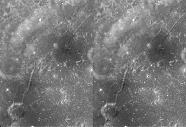 This
is a stereo image of the unusual linear grooves or canyons connecting the
craters from the left side of the mosaic above. Note the unusual dome and
anomalous structures on the left side of the image.
This
is a stereo image of the unusual linear grooves or canyons connecting the
craters from the left side of the mosaic above. Note the unusual dome and
anomalous structures on the left side of the image.
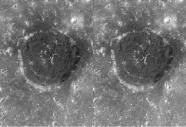 This
is a stereo image of the dark crater in the mosaic above. Notice the numerous
anomalous within and surrounding this crater.
This
is a stereo image of the dark crater in the mosaic above. Notice the numerous
anomalous within and surrounding this crater.
 This
is a false color image of the anomalous crater above, using 900, 950, and
1000 nm filter images combined as blue, green, and red images, respectively.
This
is a false color image of the anomalous crater above, using 900, 950, and
1000 nm filter images combined as blue, green, and red images, respectively.
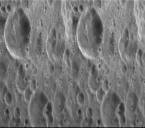 This
stereo section on the farside of the moon shows a very unusual anomalies.
Image has been rotated to preserve the stereo perspective.
This
stereo section on the farside of the moon shows a very unusual anomalies.
Image has been rotated to preserve the stereo perspective.
 This
is a color composite of the same area, made from images using filters at
900 nm, 950 nm, and 1000 nm, (blue, green, red).
This
is a color composite of the same area, made from images using filters at
900 nm, 950 nm, and 1000 nm, (blue, green, red).
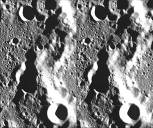 This
is another stereo image of an anomalous area on the farside of the moon.
This
is another stereo image of an anomalous area on the farside of the moon.
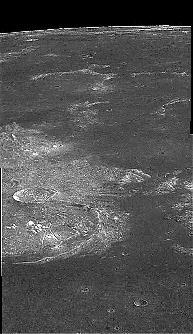 This
mosaic is processed from raw data from Clementine
mission. Image Meta Data is available
for the raw image LUB10112.GIF, which is at the
approximate center of the crater Gassendi.
This
mosaic is processed from raw data from Clementine
mission. Image Meta Data is available
for the raw image LUB10112.GIF, which is at the
approximate center of the crater Gassendi.
This mosaic of Clementine images from orbit 314 shows what appears to
be a moon base and mining operation. These images are online on NASA's
Clementine Navigator.
 This
mosaic showing the inside of the right rim of Gassendi as shown in the
previous mosaic. This image is inverted from the previous mosaic, with
north toward the bottom of the image. Notice that this 'mining area' is
opposite of the piles of tailings outside of the right side of Gassendi
as seen in the first mosaic of Gassendi.
This
mosaic showing the inside of the right rim of Gassendi as shown in the
previous mosaic. This image is inverted from the previous mosaic, with
north toward the bottom of the image. Notice that this 'mining area' is
opposite of the piles of tailings outside of the right side of Gassendi
as seen in the first mosaic of Gassendi.
 This
mosaic shows Gassendi, and the smaller crater Clarkston with the same orientation,
north to the bottom of the image.
This
mosaic shows Gassendi, and the smaller crater Clarkston with the same orientation,
north to the bottom of the image.
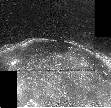 This
mosaic shows the front of Gassendi. Notice the unusual triangular formation,
and other linear features.
This
mosaic shows the front of Gassendi. Notice the unusual triangular formation,
and other linear features.
 This
is another view to the right of the image above, taken from a later orbit.
Note the strange oval object spanning the large boulders.
This
is another view to the right of the image above, taken from a later orbit.
Note the strange oval object spanning the large boulders.
 This
is a mosaic of four images from orbit 246 with South toward the top of
the image. This is supposedly a Russian supply base, according to Dr. Beter.
This
is a mosaic of four images from orbit 246 with South toward the top of
the image. This is supposedly a Russian supply base, according to Dr. Beter.
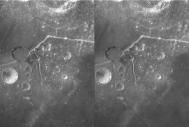 This
is a stereo image showing part of the mosaic. Some of the more interesting
anomalies include the unusual series of ridges or tunnels and the bright
objects that appear within on above these linear features. The crater to
the left center appears to have anomalous linear objects (mining transports?)
parked near the edge.
This
is a stereo image showing part of the mosaic. Some of the more interesting
anomalies include the unusual series of ridges or tunnels and the bright
objects that appear within on above these linear features. The crater to
the left center appears to have anomalous linear objects (mining transports?)
parked near the edge.  This
is another view of the area near Jules Verne Crater.
This
is another view of the area near Jules Verne Crater.  A
closer view showing the crater and nearby linear features.
A
closer view showing the crater and nearby linear features. 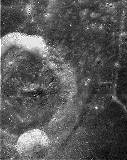 A
closer view of the crater. Note the unusual features on the dome at a the
lower part of the image.
A
closer view of the crater. Note the unusual features on the dome at a the
lower part of the image. 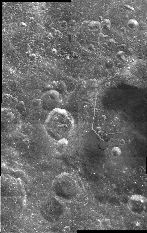 This
mosaic, made from twelve Clementine images, shows the the many anomalous
features of this area, including linear features and their relationship
to the unusual craters and other anomalies.
This
mosaic, made from twelve Clementine images, shows the the many anomalous
features of this area, including linear features and their relationship
to the unusual craters and other anomalies.  This
image shows a anomalous linear structures on the top of a dome. Is this
a mining operation as well, or perhaps a spaceport?
This
image shows a anomalous linear structures on the top of a dome. Is this
a mining operation as well, or perhaps a spaceport?  This
stereo image of the above structure was made from images taken with two
different light filters at slightly different points on the orbit. Note
the how unusual linear and radial structures within this area can be seen
in both images, along with some differences.
This
stereo image of the above structure was made from images taken with two
different light filters at slightly different points on the orbit. Note
the how unusual linear and radial structures within this area can be seen
in both images, along with some differences.  Processed
version of LUB21349.GIF showing unusual domes
Processed
version of LUB21349.GIF showing unusual domes  This
area near the Sea of Crises, is supposedly the location of a Russian Cosmosphere
Base, according to Dr. Beter. Note linear structures in the canyon, and
large spherical object surrounded by smaller spheres inside the crater.
The crater is Proclus. This crater has the third highest number of Lunar
Transient Phenomina reports of all areas of the moon
(list of LTP areas).
This
area near the Sea of Crises, is supposedly the location of a Russian Cosmosphere
Base, according to Dr. Beter. Note linear structures in the canyon, and
large spherical object surrounded by smaller spheres inside the crater.
The crater is Proclus. This crater has the third highest number of Lunar
Transient Phenomina reports of all areas of the moon
(list of LTP areas). This
is a stereo version of the crater in the upper left corner of the above
image. This image is somewhat overprocessed for sharpness, showing horizontal
and vertical jpeg compression artifacts. However, the objects are not processing
artifacts and appear similar in images taken with other lightwave filters.
This
is a stereo version of the crater in the upper left corner of the above
image. This image is somewhat overprocessed for sharpness, showing horizontal
and vertical jpeg compression artifacts. However, the objects are not processing
artifacts and appear similar in images taken with other lightwave filters.
 This
is a 2X interpolated image of Proclus processed with an edge sharpening
filter to bring out more detail in the spheres. Some of the spheres surrounding
the larger object appear to be connected. Note that in this image the large
sphere appears to be split or may actually consist of two objects.
This
is a 2X interpolated image of Proclus processed with an edge sharpening
filter to bring out more detail in the spheres. Some of the spheres surrounding
the larger object appear to be connected. Note that in this image the large
sphere appears to be split or may actually consist of two objects.  This
is a mosaic of the area showing the pentagon-shaped crater Proclus and
the strange winding parallel linear structure, from orbit 186. Note the
strange twist in the linear structure near the center of the image.
This
is a mosaic of the area showing the pentagon-shaped crater Proclus and
the strange winding parallel linear structure, from orbit 186. Note the
strange twist in the linear structure near the center of the image. 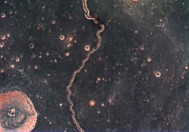 This
is a false color image processed with Maximum Entropy Deconvolution. This
algorithm compensates for defocusing due to optical distortions.
This
is a false color image processed with Maximum Entropy Deconvolution. This
algorithm compensates for defocusing due to optical distortions.
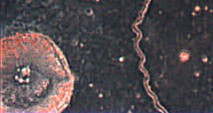 This
is a 2x enlargement of the image above. The large circular object resembles
a satellite dish or possibly a large circular tank. (hydrogen?)
This
is a 2x enlargement of the image above. The large circular object resembles
a satellite dish or possibly a large circular tank. (hydrogen?)
 Processed
image of Messier Crater showing many anomalies
Processed
image of Messier Crater showing many anomalies
 Crater
with strange cross-shape on the edge
Crater
with strange cross-shape on the edge
 This
unusual donut-shaped crater is found in orbit 150, in images lue5227o_150.gif
and lue5228o_150.gif. Notice the symmetrical objects that flank the opening
on the left side of the crater, and the bullseye-like inner crater, which
contains two bright objects in the lower part. Here is a processed
image of the full frame made by combining the high and low gain images
to form a composite in order to preserve more detail in the bright areas.
This
unusual donut-shaped crater is found in orbit 150, in images lue5227o_150.gif
and lue5228o_150.gif. Notice the symmetrical objects that flank the opening
on the left side of the crater, and the bullseye-like inner crater, which
contains two bright objects in the lower part. Here is a processed
image of the full frame made by combining the high and low gain images
to form a composite in order to preserve more detail in the bright areas.
 Processed
version of LUB20658.GIF showing anomalous road or depression on the side
of Kepler Crater
Processed
version of LUB20658.GIF showing anomalous road or depression on the side
of Kepler Crater
 A
closer view of the Kepler Crater
A
closer view of the Kepler Crater
 Ancient
freeway, tunnel structure, or a double fault line?
Ancient
freeway, tunnel structure, or a double fault line?
 Another
unusual area showing bright spots and domes
Another
unusual area showing bright spots and domes
 Clementine
mosaic showing a large dark area at the South Pole of the moon.
Clementine
mosaic showing a large dark area at the South Pole of the moon.
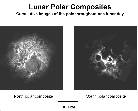 Clementine
mosaic showing both the North and South poles of the moon. The discovery
of a lake of ice at the South Pole was recently announced by the Pentagon.
Clementine
mosaic showing both the North and South poles of the moon. The discovery
of a lake of ice at the South Pole was recently announced by the Pentagon.
